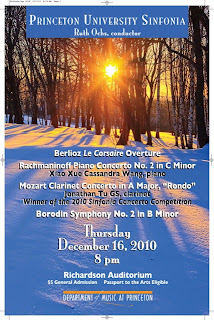The Princeton University Sinfonia gave a fun-spirited concert on December 16 at Richardson Auditorium, with Ruth Ochs as conductor. The program consisted of Berlioz’s Le Corsair Overture, Rachmaninoff’s Piano Concerto No. 2 (Cassandra Wang, piano), Rondo from Mozart’s Clarinet Concerto in A Major (Jonathan Tu, clarinet), and Borodin’s Symphony No. 2.
Berlioz’s Le Corsair Overture served as a riveting, bombastic opening to the concert, with Berlioz’s typical “come to the greatest show on earth” feel. Berlioz wrote the original version of this overture in August 1844 at Nice and led its first performance in Paris on January 19, 1845, then called La Tour de Nice (The Tower of Nice). Although the orchestra started off a little shaky, with entrances that could have been more confident, things eventually came together as the melody unfolded in the first section. Finally, the booms of the tympani resonating throughout the hall and the blaring brass served as a grandiose end to the beginning of a lively concert.
From such bombastic show of display, we are brought into another type of display: subtle virtuosity in Rachmaninoff’s famous Piano Concerto No. 2, composed in 1900-1901 and premiered with Rachmaninov himself as the soloist on November 9, 1901, in Moscow. I emphasize “subtle” virtuosity despite the obvious technical difficulty of the piece as a compliment to Cassandra Wang, the pianist. Cassandra glides through the runs with seeming effortlessness, and makes the most difficult of passages seem easy. Her playing reminds me of that of Yefin Bronfman’s, with a stoic body concealing the most expressive sounds. Her tone is warm and lyrical, taking the listener sighing into a far away dreamscape, especially in the beautiful adagio sostenuto. Cassandra deserves special commendation for her discerning ability to stay with the orchestra. The orchestra took the piece overall much slower than it is normally played, especially in Mvt. I and III, yet Xiao was able to restrain herself from the urge to rush (although noticeable) extremely well and patiently. Although being greatly under tempo, and intonation issues in soloists (oboe), Cassandra’s solid and expressive performance made this piece the highlight of the concert.
Leaving behind the brilliant Romanticism of Rachmaninoff and the piano, we are transported to the wonderfully Classical world of Mozart and the clarinet in the Rondo from Mozart’s Clarinet Concerto in A Major. Mozart famous and only concerto for clarinet, known for its delicate interplay between orchestra and soloist, was written in 1791 for the clarinetist Anton Stadler. The clarinetist of the Sinfonia concert was Jonathan Tu, a graduate student at Princeton University and winner of the 2010 Sinfonia Concerto Competition. Despite a beautiful and warm tone, Jonathon had some trouble with his embouchure and excess air was often heard as he played. Nevertheless, the piece was quite enjoyable, maybe even a little too pleasant. In a way, the Mozart sounded a little too “perfect,” too “nice.” What was lacking in this performance, in both the orchestra and the soloist, was the feel of Mozartian whimsicality and playfulness. The dynamics were a little flat, and more contrasts would have made the experience more “fun,” in the playful Mozart style.
Finally, the concert ended with the heroic Borodin Symphony No. 2. The symphony was composed intermittently between 1869 and 1876, and is considered the most important large-scale work completed by the composer himself. Again, unconfident entrances took away from the boldness of the piece, especially in the opening sectional entrances of the Allegro theme. However, as the piece progressed, some really nice sounds started to come together. The double-tonguing of the brass in the Scherzo was effective in creating a underlying current of arousal, the vibratos of the strings created a wonderfully evanescent sound effect in the Andante, and the strong brassy sound at the end Finale served as a bold conclusion of finality. Sinfonia performed a concert of many popular delights in a more casual atmosphere. Though not a world-class orchestra, or the PUO, Sinfonia transports us to various places of musical adventure in a less intense manner.
















